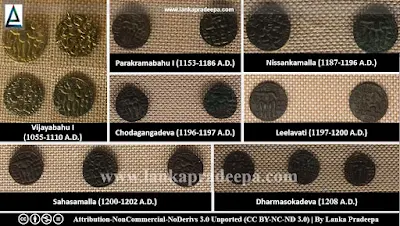
Human settlements in Polonnaruwa can be dated back to the 2nd century B.C. (Jayasuriya, 2016). Gopalapabbata, a cave site located within the present Polonnaruwa ancient city furnishes evidence of the early inhabitants of the area. During the period of the Anuradhapura Kingdom (377 B.C.-1017 A.D.), Polonnaruwa was known as Kandavuru-Nuwara (the camp city) as it was situated at a strategic position between the Northern capital Anuradhapura and the Southern sub-capital Mahagama (Jayasuriya, 2016; Prematilaka & Hewage, 2018). According to the details given in Culavamsa, King Aggabodhi III (626-641 A.D.) built a Buddhist monastery named Mahapanadipa Viharaya in Polonnaruwa in the 7th century A.D. (Nicholas, 1963). In the same century, King Aggabodhi IV (658-674 A.D.) removed the seat of government from Anuradhapura to Polonnaruwa and resided there until his death (Nicholas, 1963). Several other rulers in the 8th and 9th centuries A.D. such as King Aggabodhi VII (772-777 A.D.) and Sena I (833-853 A.D.) also resided at Polonnaruwa (Nicholas, 1963). During this era, several reservoirs were built in and around the Polonnaruwa by the Anuradhapura kings (Jayasuriya, 2016).
Foreign invasions caused the wane of the political stability of the Anuradhapura Kingdom and as a result of that, the Sri Lankan rulers were attracted to Polonnaruwa as they found it safer ground than their first capital Anuradhapura. The invasions made by South Indian Cholas since the end of the 10th century resulted in the gradual downfall of the Anuradhapura Kingdom.
The Chola conquest of Anuradhapura began with the invasion in 993 A.D. by King Raja Raja I (c. 985-1014 A.D.) who sent a large Chola army to Sri Lanka. In 1017 A.D., during the reign of Rajendra Chola I (c.1014-1044 A.D.), the Anuradhapura Kingdom fell under the rule of the Chola Empire when the invaders took the last king of Anuradhapura, King Mahinda V (982-1017 A.D.) as a captive to India (see: Fort Hammenhiel inscriptions). The Cholas established their rule in Polonnaruwa through a viceroy and renamed the city as Jananatha Mangalam (Jayasuriya, 2016; Nicholas, 1963). They ruled the country for 53 years until King Vijayabahu I (1055-1110 A.D.) defeated them and re-established the Sinhalese lineage in 1070 A.D. The Chola hegemony in Polonnaruwa for nearly five decades made a major influence on the culture of the island as well as resulted in the emergence of Polonnaruwa as the second great capital of Sri Lanka.
Vijayabahu I expelled the Cholas and established the Sinhalese Kingdom again in the country after the demise of the Anuradhapura Kingdom (Jayasuriya, 2016). He celebrated his coronation as king at Anuradhapura but shortly afterwards transferred the capital to Polonnaruwa (Nicholas, 1963). Therefore, Vijayabahu I is considered the first king to establish Polonnaruwa as the capital (Jayasuriya, 2016; Prematilaka & Hewage, 2018). Changes were done in political, social, religious, and economic aspects during this reign. He got down Buddhist monks from Myanmar to revive Buddhism in the country (Jayasuriya, 2016). However, the administrative success of Vijayabahu I was come to a virtual halt soon after his death due to the internal conflicts created by several contenders to the throne (Jayasuriya, 2016). Velaikkara Tamil Inscription gives some details about the Velaikkara revolt that erupted during Vijayabahu's reign and about the problematic period that occurred soon after the death of Vijayabahu I (Wickremasinghe, 1928).
Parakramabahu I (or Parakramabahu the Great) emerged as the most successful ruler after King Vijayabahu I. He is considered the greatest and the most reputed ruler of Polonnaruwa who brought the country's economy, culture, and religion to the zenith of the period (Jayasuriya, 2016). His achievements in agriculture and irrigation, trade and foreign relations (see: Nagadeepa inscription), and cultural activities made the Polonnaruwa era one of the most shining and successful periods of Sri Lankan history (Indrapala, 1963; Nicholas, 1963). The unification of the divided communities of Buddhist monks [see: Katikavata inscription of Parakramabahu I (Gal Vihara Ordinance)], the war against Myanmar (see: Devanagala inscription of Parakramabahu I), and the Sinhalese expedition against the Pandya country (see: Arpakkam inscription) are a few of important events of the Parakramabahu's period (Jayasuriya, 2016; Paranavitana, 1933; Wickremasinghe, 1928).
Nissankamalla of the Kalinga Dynasty was able to continue the program of work established by Parakramabahu I (Jayasuriya, 2016; Nicholas, 1963). He is credited with the most number of inscriptions in Polonnaruwa (Jayasuriya, 2016).
The throne of the Polonnaruwa after Nissankamalla was transitioned to the hands of several rulers who were weak in reigning or who engaged in internecine struggles (Dias et al., 2016). As a result of that, the country's political stability became poorer and the situation was comported for the invasions carried out by several Tamil invaders from South India such as Parakrama Pandya (1212-1216 A.D.). Magha of Kalinga (India) who came with a large army from Malabar (Kerala) invaded Sri Lanka during the reign of Parakrama Pandya and became the ruler of the country (Dias et al., 2016). He ruled the island for 21 years until 1236. Due to the invasions that mainly came from South India, Polonnaruwa was abandoned in the first quarter of the 13th century and the seat of government for the Sinhalese kings was moved to Dambadeniya (Jayasuriya, 2016).
Period of Chola rule (1017-1070 A.D.) Vijayabahu I (1055-1110 A.D.)
Jayabahu I (1110-1111 A.D.) Vikramabahu I (1111-1132 A.D.)
Gajabahu II (1132-1153 A.D.) Parakramabahu I (1153-1186 A.D.)
Vijayabahu II (1186-1187 A.D.) Mahinda (1187-1187 A.D.)
Nissankamalla (1187-1196 A.D.) Veerabahu (1196-1196 A.D.)
Vikramabahu II (1196 A.D.) Chodagangadeva (1196-1197)
Queen Lilavathi (1st round: 1197-1200 A.D.) Sahassamalla (1200-1202 A.D.)
Queen Kalyanavathi (1202-1208 A.D.) Darmashokadeva (1208-1209 A.D.)
Commander Anikanga (1209-1209 A.D.) Queen Lilavathi (2nd round: 1209-1210 A.D.)
Commander Lokeshwara (1210-1211 A.D.) Queen Lilavathi (3rd round: 1211-1212 A.D.)
Parakrama Pandya (1212-1216 A.D.) Kalinga Magha (1216-1236 A.D.)
(After Vijayabahu I (1055-1110 A.D.), there were three rulers in the country; Manabharana in Dakkhinadesa, Siriwallabha in Dolosdahasrata, and Kithirimegha in Atadahaserata).
2) Indrapala, K., 1963. The Nainativu Tamil Inscription of Parakramabahu I. University of Ceylon Review. Vol. XXI; No, I. University of Ceylon. Peradeniya. pp.63-70.



